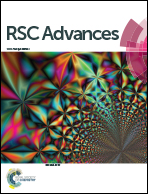Preparation and in vitro bioactivity evaluation of N-heterocyclic-linked dihomooxacalix[4]arene derivatives†
Abstract
Based on the superior prospects of calixarenes-based agents and N-heterocyclic pharmacophores in biomedical applications, 14 new dihomooxacalix[4]arene N-heterocyclic (pyridine, quinoline, and thiazole) derivatives 4a–4n were efficiently synthesized from the parent compound, namely, p-tert-butyldihomooxacalix[4]arene 1; they were further investigated by using their IR, 1H NMR, 13C NMR, and HRMS spectra. Among these derivatives, the crystal and molecular structures of 2-aminomethyl-pyridine-substituted dihomooxacalix[4]arene 4f (obtained from methanol) have been determined by X-ray diffraction. In the case of the inhibition assay of cell growth, we evaluated the effects on four select tumor cell lines (MCF-7, HepG2, SKOV3, and HeLa), as well as the normal cell lines of HUVEC, using paclitaxel as the positive control drug. It was found that the derivatives 4d–4f, 4i, 4k, and 4l could inhibit tumoral activity up to varying degrees. Mechanistically, the cell cycle analysis demonstrated that dihomooxacalix[4]arene N-heterocyclic derivatives could induce apoptosis of MCF cells. In addition, the results of the western blot and immunofluorescence studies revealed the upregulation of the protein expression levels of Bax and cleaved caspase-3, as well as the downregulation of Bcl-2, which are in good agreement with the corresponding inhibitory potencies. Therefore, these findings suggest that N-heterocyclic derivatives based on the dihomooxacalix[4]arene scaffold are promising candidates for use against cancer.
![Graphical abstract: Preparation and in vitro bioactivity evaluation of N-heterocyclic-linked dihomooxacalix[4]arene derivatives](/en/Image/Get?imageInfo.ImageType=GA&imageInfo.ImageIdentifier.ManuscriptID=C9RA06876G&imageInfo.ImageIdentifier.Year=2019)


 Please wait while we load your content...
Please wait while we load your content...